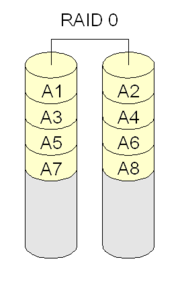Back
Next
A word on error checking and recovery.
RAID provides ability to recover lost drive once it has been identified
and allows system to stay up in spite of failed drive.
# Except RAID 0
Byte/bit level errors are caught by the Reed-Solomon code that is part of
the data stored in a sector.
JBOD (Just a Bunch Of Discs) and Virtual file-system.
The 1st goal - to cluster a group of cheap drives together in a user
friendly (single virtual device) configuration,
can be done without RAID protocol.
Logical Volume Manager.
Uses a database overlay to make multiple drives/partitions appear as a
single storage area.
+ Works well with mixed sized disks.
+ Mainly to allow multiple discs to appear as a single drive or directory.
Simply mount drive and tell virtual file management that it has more
storage.
- No data protection or replication.
`
- No parallel access to drives, so no performance improvement.
- Lack of internal structure, a file can be one disc or spread across
several drives. Overhead of tracking files may slow access some.
* Windows Vista - dynamic disk.
RAID level 0
Uses stripes arranged in a round robin fashion over 2 or more discs.
Can be implemented with SCSI or any ATA-IDE.
Can work with just 2 drives.
Cheapest implementation - treats storage as a single large disk.
With best controllers - parallel reads, high throughput.
Multiple sectors of a single file may be accessed at same time.
Only matched size partitions used on RAID, so less waste if drives
physically same size.
Better throughput if master controller implements RAID
and each drive on its own controller.
Excellent read and very good write speeds.
Best with non-changing backed up data.
Best performance with large stripes.
No error protection or data redundancy.
Disc failure fatal for all data.
Multiple discs increase chance of disk failure.


